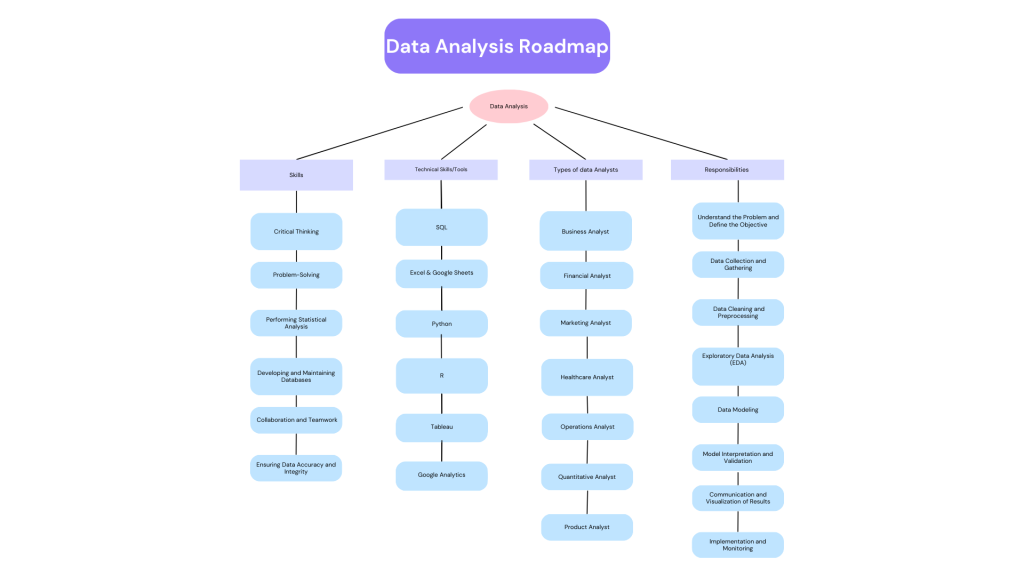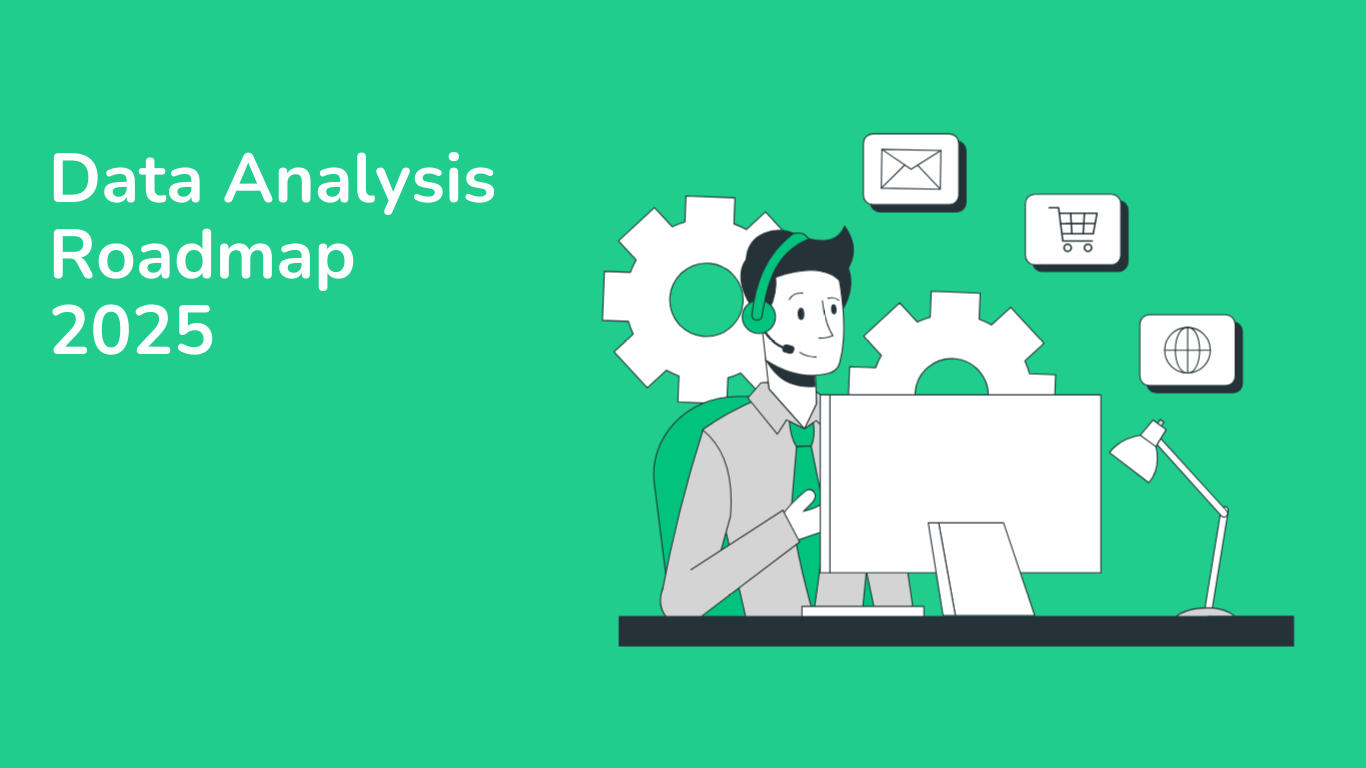Data analysis is a dynamic, fast-growing field with endless opportunities. But let's be honest—getting started can feel like standing at the edge of an ocean, unsure where to dive in. Do you focus on learning statistics first? Or should you master Excel, Python, or SQL? It’s easy to get lost in the options. But don't worry, you're not alone on this journey!
Have you ever wondered how businesses make decisions based on numbers and data? Or maybe you're intrigued by how analysts predict trends and uncover hidden insights? If so, you're in the right place.So, are you ready to embark on this exciting adventure in the world of data? 🚀 Let’s get started!
Here is the ultimate roadmap to start your carrier in Data Analysis and ready to Dive in the field of data.
There are the steps you that’s you follow to start your learning in a right way.

Skills
Data analysts need strong analytical skills to assess the data's quality, draw conclusions, and solve problems.
a. Critical Thinking
Being able to evaluate the data, question assumptions, and think critically about patterns and correlations is key for a data analyst to provide meaningful insights.
b. Problem-Solving
Data analysts often work with ambiguous or incomplete data, requiring them to come up with creative solutions. Problem-solving skills help identify the best way to structure data or make sense of complicated datasets.
c. Attention to Detail
Accurate data analysis requires great attention to detail to ensure that no error is overlooked, especially when cleaning and processing the data.
3. Communication and Soft Skills
Being able to communicate insights effectively is as important as the technical analysis.
a. Data Storytelling
A data analyst should be able to translate complex data findings into clear, actionable insights for non-technical stakeholders. This requires the ability to create a narrative around the data using visualizations and simple explanations.
b. Collaboration and Teamwork
Data analysts often work with data scientists, engineers, business managers, and other stakeholders. Therefore, collaboration and communication skills are crucial to understanding the business requirements and explaining findings.
c. Time Management
Given the iterative nature of data analysis, the ability to manage time effectively, prioritize tasks, and meet deadlines is essential.
4. Domain Knowledge
While technical skills are essential, understanding the domain in which you are working can greatly enhance the value you add as a data analyst.
- Industry-Specific Knowledge: Whether you work in finance, healthcare, e-commerce, or any other industry, knowing the specific metrics and challenges of that industry will help you provide more relevant and actionable insights.
5. Performing Statistical Analysis
- Responsibility: Using statistical methods and tools to analyze data trends and conduct hypothesis testing to validate assumptions and identify relationships within the data.
6. Ensuring Data Accuracy and Integrity
- Data Analyst Ensuring the accuracy and quality of the data being used in analysis. This involves continuous monitoring of data sources and processes to avoid errors or inconsistencies.
7. Developing Predictive Models (Basic Level)
- For more advanced data analysts, using statistical and machine learning models to predict future trends or behaviors based on historical data.
Technical Skills
These are the core competencies required to work with data.
Data Analysis Tools
- Excel/Spreadsheets: Excel remains one of the most widely used tools for data manipulation, basic analysis, and visualization.
- SQL (Structured Query Language): SQL is essential for querying relational databases, extracting data, and managing large datasets.
- Programming Languages (Python/R): Python and R are powerful languages for data analysis. Python, with libraries like Pandas, NumPy, and Matplotlib, is widely used for data manipulation and visualization. R, with its rich set of statistical packages, is preferred for advanced statistical analysis.
- Data Visualization Tools: Tools like Tableau, Power BI, and Google Data Studio are essential for creating interactive dashboards and visualizing complex data insights in an accessible manner.
b. Statistical Analysis
- Descriptive Statistics: Understanding mean, median, mode, standard deviation, and variance helps in summarizing and interpreting data.
- Inferential Statistics: Knowledge of hypothesis testing, t-tests, chi-square tests, ANOVA, and correlation techniques is crucial for making data-driven decisions and drawing conclusions.
c. Data Cleaning and Preprocessing
- Data analysts spend a significant portion of their time cleaning raw data, handling missing values, and removing outliers. Skills in using Pandas (Python), dplyr (R), and data wrangling libraries are crucial.
d. Machine Learning Basics
Although not always required, having a basic understanding of machine learning concepts such as supervised vs unsupervised learning, regression, and classification can be beneficial. Tools like scikit-learn and TensorFlow (Python) can be helpful.
e. Database Management
- Relational Databases (SQL-based systems): Knowledge of database management systems like MySQL, PostgreSQL, and MS SQL Server is essential for working with structured data.
- NoSQL Databases: Familiarity with non-relational databases like MongoDB and Cassandra helps when dealing with unstructured data.
Types of Data Analysts
Data analysts may specialize in various areas, each focusing on different types of analysis or industries. Here are some of the most common types of data analysts:
1. Business Analyst
A Business Analyst focuses on identifying business needs, gathering requirements, and analyzing business processes. They bridge the gap between technical teams and business stakeholders, helping translate data insights into actionable business strategies.
- Skills Needed: Business intelligence, process modeling, requirements gathering, and communication.
- Typical Tasks: Gathering business requirements, reporting on key performance indicators (KPIs), creating dashboards, and providing recommendations to improve business operations.
2. Financial Analyst
Financial Analysts analyze financial data to help companies make investment decisions, optimize costs, and improve financial performance.
- Skills Needed: Financial modeling, forecasting, budgeting, accounting principles, and strong Excel skills.
- Typical Tasks: Analyzing income statements, balance sheets, forecasting revenues, and conducting risk analysis.
3. Marketing Analyst
Marketing Analysts focus on understanding consumer behavior, tracking marketing campaigns, and measuring ROI to help businesses optimize their marketing strategies.
- Skills Needed: Market research, digital marketing metrics (CPC, CPA, conversion rates), data visualization, and SQL.
- Typical Tasks: Analyzing customer demographics, campaign performance, social media data, and generating insights on customer acquisition and retention.
4. Healthcare Analyst
Healthcare Analysts work in the medical field, analyzing data from hospitals, clinics, and other healthcare providers to improve patient outcomes, operational efficiency, and cost management.
- Skills Needed: Knowledge of healthcare systems, familiarity with Electronic Health Records (EHR), HIPAA compliance, and healthcare regulations.
- Typical Tasks: Analyzing patient data, predicting disease trends, improving patient care models, and evaluating hospital performance.
5. Operations Analyst
Operations Analysts focus on improving internal processes, optimizing supply chains, and identifying operational inefficiencies within a company.
- Skills Needed: Process optimization, supply chain management, project management, and statistical analysis.
- Typical Tasks: Evaluating operational performance, identifying cost-saving opportunities, and recommending process improvements.
6. Data Scientist
Although slightly different from data analysts, Data Scientists often have a more advanced skill set in machine learning and predictive analytics. They build models to forecast trends and perform advanced data manipulation.
- Skills Needed: Machine learning, programming (Python/R), statistics, and deep learning.
- Typical Tasks: Building predictive models, handling unstructured data, and implementing algorithms.
7. Quantitative Analyst
Often found in finance and investment firms, Quantitative Analysts (or "Quants") focus on analyzing numerical data to create mathematical models for financial markets.
- Skills Needed: Advanced mathematics, financial engineering, probability theory, and programming.
- Typical Tasks: Creating models for pricing financial instruments, managing risks, and developing algorithms for high-frequency trading.
8. Product Analyst
Product Analysts focus on user data and product performance to help improve products and enhance the user experience.
- Skills Needed: A mix of technical and product management skills, user testing data, and experience with A/B testing.
- Typical Tasks: Analyzing user feedback, tracking user behavior, and making recommendations to improve product features or user interface (UI).
Data Analyst Responsibilities
A Data Analyst plays a crucial role in interpreting and analyzing data to help organizations make informed decisions. Their responsibilities can vary depending on the industry and the specific goals of the organization, but here are the core responsibilities of a data analyst:
1. Data Collection and Gathering
- Responsibility: Collecting relevant data from various sources, such as databases, surveys, APIs, or other data storage systems.
- Example: Gathering sales data, customer feedback, or web traffic data to analyze patterns.
2. Data Cleaning and Preprocessing
- Responsibility: Cleaning and transforming raw data into a usable format by handling missing values, removing duplicates, correcting errors, and converting data types.
- Example: Removing duplicate entries in customer data or filling in missing values in a dataset.
3. Data Exploration and Analysis (Exploratory Data Analysis - EDA)
- Responsibility: Performing exploratory analysis to understand trends, patterns, and relationships in the data. This might involve calculating summary statistics and using data visualization techniques to identify key insights.
- Example: Using tools like Python’s
Pandas,Matplotlib, orSeabornto explore correlations between different variables, like customer age and purchasing behavior.
4. Data Visualization
- Responsibility: Creating visual representations of the data (such as charts, graphs, and dashboards) to make complex data easily understandable for stakeholders.
- Example: Designing a dashboard in Power BI or Tableau to visually display sales performance metrics over time.
5. Reporting Insights
- Responsibility: Presenting the findings of data analysis clearly and concisely to stakeholders, often in the form of written reports or presentations. The goal is to communicate actionable insights that support business decisions.
- Example: Presenting a report to management that shows which products are underperforming and suggesting areas for improvement.
6. Developing and Maintaining Databases
- Responsibility: Ensuring that data is properly stored, maintained, and organized for future use. This can involve designing, updating, and maintaining databases or data storage systems.
- Example: Managing customer databases to ensure that all records are up-to-date and accessible for future analysis.
7. Performing Statistical Analysis
- Responsibility: Using statistical methods and tools to analyze data trends and conduct hypothesis testing to validate assumptions and identify relationships within the data.
- Example: Performing regression analysis to predict future sales or testing the effectiveness of a marketing campaign.
8. Providing Recommendations for Action
- Responsibility: Based on data findings, analysts often provide actionable recommendations that help improve business strategies, operations, or performance.
- Example: Recommending changes in product pricing or suggesting targeted marketing strategies based on customer purchasing behavior.
9. Collaborating with Other Teams
- Responsibility: Data analysts often work with various teams (marketing, operations, finance, etc.) to understand their data needs and provide relevant insights.
- Example: Collaborating with the marketing team to analyze customer data and optimize ad spend.
10. Ensuring Data Accuracy and Integrity
- Responsibility: Ensuring the accuracy and quality of the data being used in analysis. This involves continuous monitoring of data sources and processes to avoid errors or inconsistencies.
11. Developing Predictive Models (Basic Level)
Example: Building a predictive model to forecast future sales based on past data.
Responsibility: For more advanced data analysts, using statistical and machine learning models to predict future trends or behaviors based on historical data.
Conclusion:
Data analysts are responsible for turning raw data into actionable insights that support business decisions. Their role involves data collection, cleaning, analysis, and communication of findings. By leveraging technical skills, analytical thinking, and domain knowledge, data analysts contribute to data-driven decision-making across organisations. Now we will give you all information about the data analyst roadmap .


Good post
hello, bro